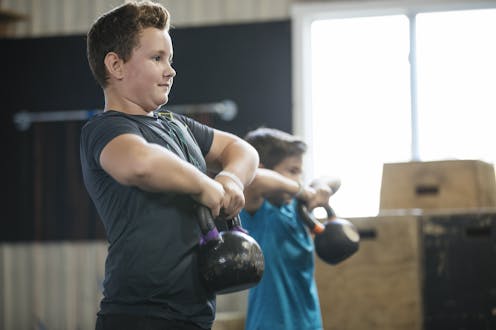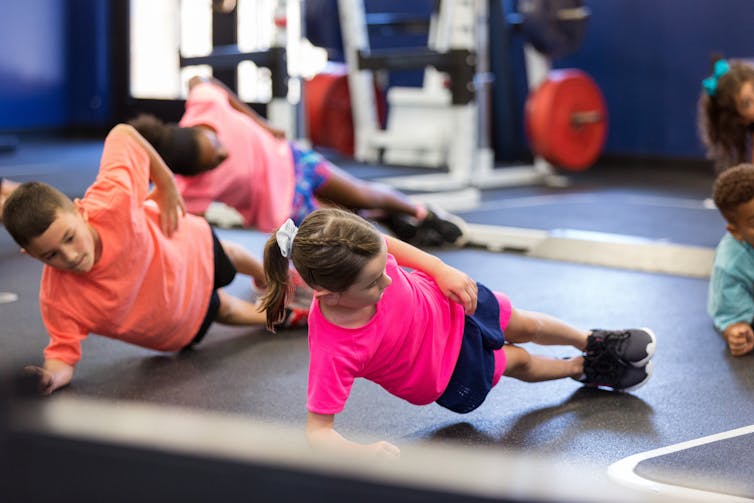Strength training early in life can set up kids and adolescents for a lifetime of health and well-be
Strength training programs for young people can improve muscle tone, prevent obesity and develop good exercise habits that last into adulthood.

“Aren’t they a little young for that?”
This is a question I used to hear regularly from parents when I’d recommend strength training for the kids I worked with, whose ages ranged from 6 to 18 years old, in youth sports. During my four years as a strength and conditioning coach, I often received questions from parents about the pros and cons of strength training – that is, training that involves weight-bearing exercises – for children.
Some of the most common questions: Is strength training safe for children and adolescents? At what age is it appropriate for them to begin strength training? What are the benefits of strength training for this age group? Is strength training beneficial even for kids who are not involved in organized sports?
Simply put, it is safe and appropriate for kids of all ages to perform strength training.
I am an exercise physiologist, certified strength and conditioning specialist and certified performance and sport scientist. My research focuses on how muscle develops from childhood to adolescence, with the goal of understanding how young people can get the most benefit out of exercise training programs, particularly strength training programs.
My experience and research has shown that strength training can help to improve sports performance for youth, and that there are significant health benefits for youth participating in strength training beyond sports performance.
Safety first
The question I receive most often, for good reason, is whether strength training is safe for youth. In a study examining injury rates in numerous sports, researchers found that, when done correctly, strength training had a lower risk of injury than nearly all other sports. This is not only true for adults but also for children.
That being said, it is important to consider a young person’s emotional maturity before handing them a dumbbell. During my career, I have designed and implemented strength training programs for kids of all ages, even as young as 6 years old. But not every child in that age range is ready for strength training. For their own safety, participants need to be emotionally mature enough to listen to and follow instructions so that they don’t hurt themselves. For some kids, that’s as early as age 6, while others may not be ready until they are a few years older.
Because correct technique is key to doing these exercises safely, it is important that strength training programs for children be designed and implemented under the guidance of a qualified trainer or coach. This means someone with valid credentials and who has received higher education in exercise science.
It’s also important to seek out professionals who use scientific evidence to back up their training programs and philosophies.

The benefits of strength training
Research has shown that stronger muscles in kids reduce the likelihood of injuries during various types of activities.
One study we conducted found that lower muscle strength and size could lead to lower performance during different activities kids typically engage in, such as running and jumping. Not only this, but kids with lower strength tend to have worse neuromuscular efficiency, which means that they are not as proficient at activating their muscles. This translates to using more energy and feeling more worn out when they’re physically active.
While it’s easy to see how strength training is important for youth who play sports, there are also incredible health benefits for kids who may not be into organized sports. Studies have shown the positive effect that strength training can have on healthy bone development in kids, leading to a lower likelihood of fractures. Research has also shown that strength training in kids can have a positive influence on psychological well-being and academic performance.
Strength training can also affect overall health and well-being as it relates to childhood obesity.
Obesity rates in children and adolescents have been rising for decades. Previous research has suggested that youth who are categorized as obese tend to have lower muscle strength than those considered normal weight. Not only this, but other research has found that youth who are obese may have a greater likelihood of sarcopenic obesity, defined as obesity with low muscle mass and function, which can have significant, negative health ramifications.
Resistance training interventions in youth with obesity have shown to have positive impacts on metabolic health, body composition, psychological health and overall quality of life.
Creating an age-appropriate program
An effective strength training program starts with setting age-appropriate expectations.
Children and adolescents are not miniature adults, and not all young people will adapt to a strength training program the same way. For instance, research shows that during puberty, there are unique differences in how muscle develops in boys versus girls.
Specifically, girls may have more neuroplasticity, which is defined as the brain’s ability to recognize new movements and patterns. This means that they may adapt to more complex movements faster than boys, while boys will see more significant changes when their muscle mass starts increasing with puberty. This doesn’t necessarily mean that girls and boys need vastly different strength training programs. It simply means not all kids will have the same rate of progression for certain exercises.
Taking that into consideration, an age-appropriate program should focus on technique over results. How much weight a child can lift is far less important than teaching them good movement patterns. For example, if a child is having difficulty performing normal pushups, a qualified professional could modify the exercise so they start with wall pushups or incline pushups. This will help that child build good movement patterns and be better for their strength in the long run.
Building off this focus on technique, a good strength training program for youth should progress from simple movements to more complex movements and lighter weights to heavier weights, taking into consideration that not all youth will adapt at the same rate.
Focusing on the long term
Obviously, most kids won’t grow up to be professional athletes, but every child can develop athleticism. A good strength training program for kids will set them on a trajectory to a healthy lifestyle from childhood to adolescence to adulthood.
Research shows that beginning exercise in childhood tends to lead to continued exercise habits in adulthood. For this reason, the National Strength and Conditioning Association, a leading organization in the field of strength and conditioning and exercise science, has encouraged a focus on improving training habits in childhood that can then be maintained into adulthood for overall better health and well-being.
Starting young with an age-appropriate strength training program can help kids develop good movement patterns and incorporate exercise into their routine, which can have lasting benefits for their health into adulthood.
Zachary Gillen does not work for, consult, own shares in or receive funding from any company or organization that would benefit from this article, and has disclosed no relevant affiliations beyond their academic appointment.
Read These Next
From truce in the trenches to cocktails at the consulate: How Christmas diplomacy seeks to exploit s
World leaders like to talk up peace at Christmastime. But alongside the tales of seasonal breaks in…
How to reduce gift-giving stress with your kids – a child psychologist’s tips for making magic and a
Depending on family circumstances and a child’s personality type, gift giving runs the gamut of fun…
The world risks forgetting one of humanity’s greatest triumphs as polio nears global eradication − 7
Polio may finally be defeated in the next 5 years. Will the world recognize what an extraordinary achievement…






